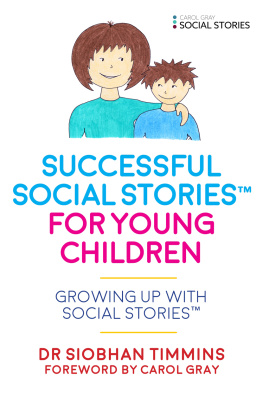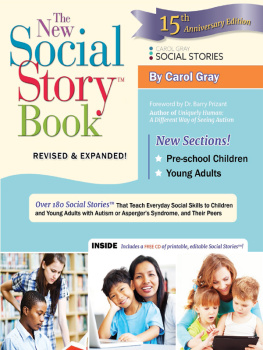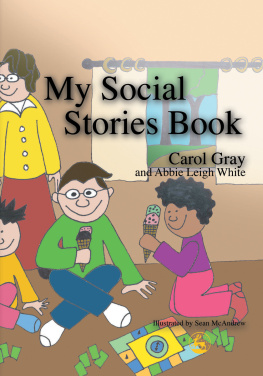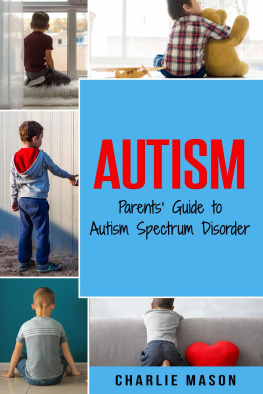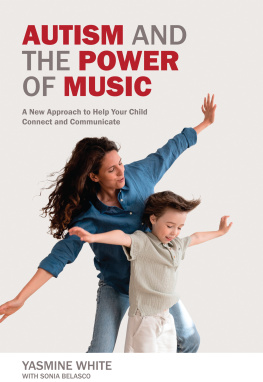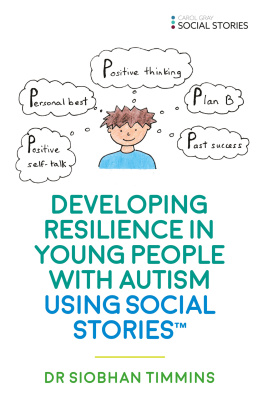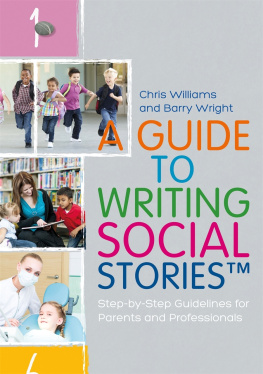
Carol Grays Social Stories are known to virtually everyone associated with Autism Spectrum Disorders. In this new book, Siobhan Timmins, parent of a child with ASD who studied under Carol Gray, helps to further explain Grays Social Stories as a way of assisting children with ASD to control behaviors and function at a higher level. The book gives a clear, detailed, and thoughtful explanation of the central ideas behind Social Stories and demonstrates how to implement the strategies with wonderful examples and terrific pictures. Anyone interested in the ideas and strategies behind Social Stories will love this clear and in depth elaboration of the theories and practices and the delightful examples of how to implement them.
Gary B. Mesibov, Professor Emeritus of Psychology and Emeritus Research Fellow at the University of North Carolina at Chapel Hill
This book is an invaluable contribution to the body of published information and guidance on Carol Grays Social Stories TM . Siobhan shares her insightful thinking and information gathering which results in impeccable stories for her son Mark. Her stories and the strategies she uses to ensure true social understanding will be inspirational to all parents and professionals.
Eileen Arnold, former specialist speech and language therapist and co-author of Revealing the Hidden Social Code: Social Stories TM for People with Autistic Spectrum Disorders
of related interest
My Social Stories Book
Edited by Carol Gray and Abbie Leigh White
Illustrated by Sean McAndrew
ISBN 978 1 85302 950 9
eISBN 978 0 85700 166 5
Revealing the Hidden Social Code
Social Stories for People with Autistic Spectrum Disorders
Marie Howley and Eileen Arnold
ISBN 978 1 84310 222 9
eISBN 978 1 84642 142 6
What Did You Say? What Do You Mean?
Jude Welton
Illustrated by Jane Telford
ISBN 9781843102076
eISBN 9781846424380
Can I Tell You About Asperger Syndrome?
A Guide for Friends and Family
Jude Welton
Illustrated by Jane Telford
ISBN 9781843102069
eISBN 9781846424229
Can I Tell You about Autism?
A Guide for Friends, Family and Professionals
Jude Welton
Illustrated by Jane Telford
ISBN 9781849054539
eISBN 9780857008299
SUCCESSFUL
SOCIAL STORIES
FOR YOUNG
CHILDREN
GROWING UP WITH
SOCIAL STORIES
SIOBHAN TIMMINS
FOREWORD BY CAROL GRAY

Jessica Kingsley Publishers
London and Philadelphia
First published in 2016
by Jessica Kingsley Publishers
73 Collier Street
London N1 9BE, UK
and
400 Market Street, Suite 400
Philadelphia, PA 19106, USA
www.jkp.com
Copyright Siobhan Timmins 2016
Foreword copyright Carol Gray 2016
All rights reserved. No part of this publication may be reproduced in any material form (including photocopying or storing it in any medium by electronic means and whether or not transiently or incidentally to some other use of this publication) without the written permission of the copyright owner except in accordance with the provisions of the Copyright, Designs and Patents Act 1988 or under the terms of a licence issued by the Copyright Licensing Agency Ltd, Saffron House, 610 Kirby Street, London EC1N 8TS. Applications for the copyright owners written permission to reproduce any part of this publication should be addressed to the publisher.
Warning: The doing of an unauthorised act in relation to a copyright work may result in both a civil claim for damages and criminal prosecution.
Library of Congress Cataloging in Publication Data
Names: Timmins, Siobhan, author.
Title: Successful social stories for young children / Siobhan Timmins ;
foreword by Carol Gray.
Description: Philadelphia : Jessica Kingsley Publishers, 2016. | Includes
bibliographical references.
Identifiers: LCCN 2016010705 | ISBN 9781785921124 (alk. paper)
Subjects: LCSH: Self-control in children. | Social perception in children. |
Social learning. | Life skills. | Autistic children.
Classification: LCC BF723.S25 T56 2016 | DDC 155.4/192--dc23 LC record available at https://urldefense.proofpoint.com/v2/url?u=https-3A__lccn.loc.gov_2016010705&d=BQIFAg&c=euGZstcaTDllvimEN8b7jXrwqOf-v5A_CdpgnVfiiMM&r=jDhEGalRBceh95Jy341lNgmWR9tnCifzbrA2NWHfaH8&m=G-jSyAkwCW8fUZRsLesTT3BEzEhOtLQF416fZj0e6LA&s=drzDAvnAzsRJBmSzme9shQDZxB21Uuy2frs2fU26lMQ&e
British Library Cataloguing in Publication Data
A CIP catalogue record for this book is available from the British Library
ISBN 978 1 78592 112 4
eISBN 978 1 78450 376 5
This book is dedicated to my son Mark, who faces all challenges with an honesty, courage and dignity that humbles me daily.
He is my inspiration.
Contents
Foreword
Early in 1994, Mark Timmins was diagnosed with autism. He was 2 years old. His mother, Siobhan, left her practice as a physician to read more about autism and how to best help her son. She learned about Social Stories at a conference, and soon after attended a Social Story training. To keep abreast of new developments, Siobhan returned to the annual workshops several times. All the while, she was writing for her son. In this first book of a three-volume series, Successful Social Stories For Young Children: Growing Up With Social Stories , Siobhan shares her experiences and insights along with Marks earliest Stories. As the person who developed Social Stories, it is my honour to introduce you to Social Stories, Dr. Siobhan Timmins and what makes this unprecedented book so valuable to those of us working with children, adolescents and adults with autism today.
Its okay if you are not familiar with Social Stories. Siobhan will aptly describe them on the following pages. Until then, all that you need is an introductory understanding of Social Stories. For that, well start with Haikus. Haiku is a Japanese form of poetry governed by rules of format. In a Haiku, for example, seventeen syllables are divided among three lines of five, seven, and five syllables respectively, with the inclusion of at least one seasonal reference. If an author doesnt follow the rules, its not a Haiku.
Similarly, Social Stories are a defined type of story. For this reason, the term Social Story is always capitalised, as is Story when used in reference to a Social Story. Each Story shares information via a format that is most likely to be understood by someone with autism. As with Haikus, authors of Social Stories follow rules, referred to as criteria or defining characteristics. Deviating from the format may result in a story, but it is not a Social Story. Every Social Story has distinguishing characteristics that work to enhance meaning and, most importantly, safety for people with autism.
For many parents, the effort to become an informed and effective parent of a child with autism in the early 1990s led to more confusion and self-doubt than assurance and confidence. In 1994, the year that Siobhans son, Mark, was diagnosed, I was an educational consultant for children with autism. I remember parents describing the search for answers as overwhelming and exhausting. That was my experience as well. Widespread use of the Internet was a few years away. Parents encountered a relatively new field, a jungle of research, ideas, trends, and conflicting opinion. Good intentions were at risk of embracing new ideas without any pre-requisite filters, interviews or evaluation. It was an unbridled intentness that often translated into zigzag educational programming, with valuable time consumed by trend and indecision.
Next page
